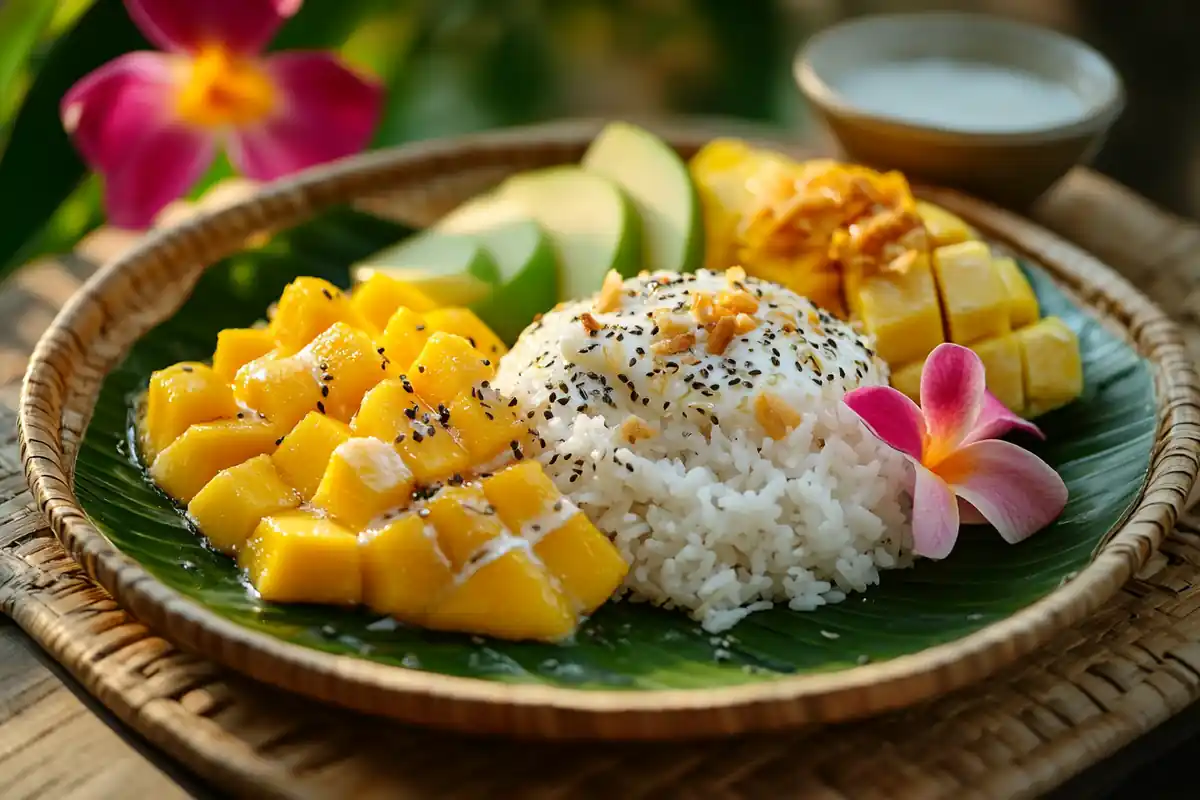Asian desserts are a world of wonder. With vibrant flavors, unique textures, and fascinating cultural roots, they offer something for everyone. From Japan’s delicate mochi to India’s rich gulab jamun, every bite tells a story. This article dives deep into the sweet treats of Asia, revealing regional specialties, key ingredients, simple recipes, and festive favorites. Whether you’re a seasoned cook or a dessert enthusiast, these dessert recipes Asian style will inspire your next culinary adventure.
Discover the World of Asian Dessert Recipes
Overview of Asian Desserts
Asian desserts are as diverse as the continent itself. They’re rooted in cultural traditions that date back centuries and use ingredients that are distinctively Asian. Unlike Western desserts that often rely on heavy creams and sugars, Asian sweets frequently feature tropical fruits, rice-based ingredients, and natural flavors like coconut and pandan. It’s this balance of sweetness and freshness that sets them apart.
For instance, desserts like Japanese mochi or Thai mango sticky rice celebrate simplicity, while Indian sweets such as gulab jamun are rich and indulgent. This broad spectrum ensures that no matter your taste, there’s a treat waiting for you.
Unique Characteristics of Asian Desserts
The magic of Asian desserts lies in their ability to blend contrasting flavors and textures. Think of the chewy bite of glutinous rice cakes, the creamy coolness of kulfi, or the delicate crispness of an egg tart. Many of these treats also have symbolic meanings tied to cultural celebrations—Chinese mooncakes during the Mid-Autumn Festival, for instance, or halo-halo as a summer favorite in the Philippines.
Moreover, Asian desserts are often lighter than their Western counterparts, making them a refreshing way to end any meal. These treats also frequently feature ingredients like red bean paste, matcha, and coconut milk, which are both nutritious and delicious.
Importance of Traditional and Modern Variations
Traditional recipes like leche flan or pandan waffles continue to hold a cherished place in households across Asia. However, modern variations have also emerged, blending Western techniques with Asian flavors to create something entirely new. Take matcha tiramisu or ube cheesecakes as examples—they’re a perfect fusion of East meets West, appealing to global palates while preserving the essence of Asian culinary artistry.
Asian desserts are a beautiful mix of nostalgia and innovation. By embracing both traditional and modern takes, you can enjoy the full spectrum of flavors that Asian cuisine has to offer. Don’t just take our word for it—explore these recipes, try something new, and immerse yourself in the delightful world of Asian dessert recipes.
Popular Asian Desserts by Region
East Asian Desserts
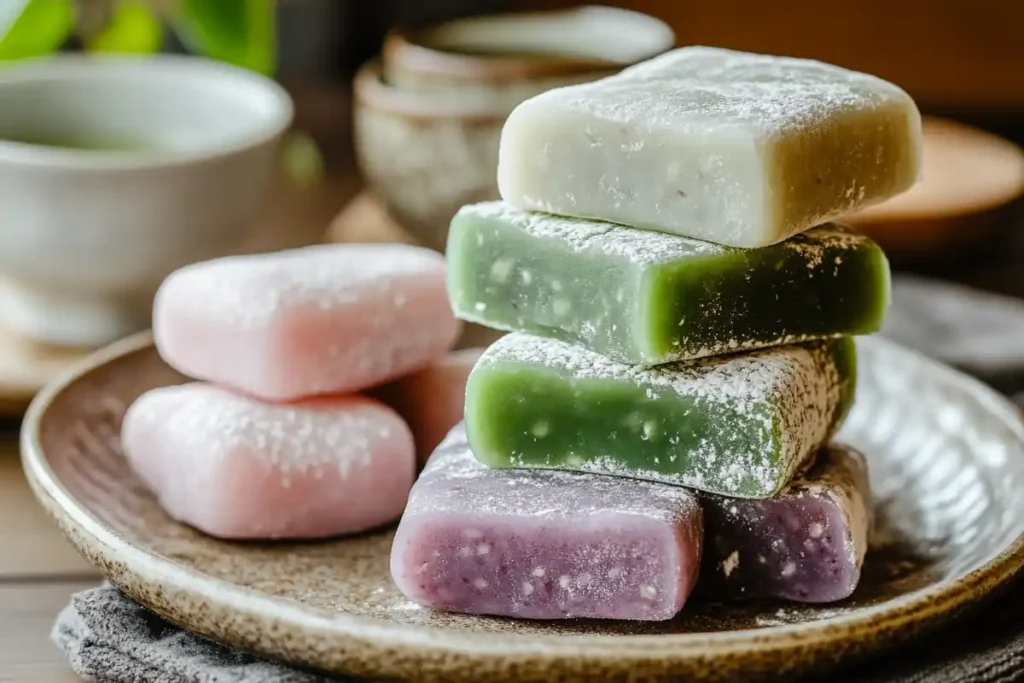
Japanese Mochi and Dorayaki
Japan’s desserts are a harmonious blend of artistry and simplicity. Mochi, a chewy rice cake, is one of Japan’s most iconic sweets. Traditionally made from glutinous rice, it’s often filled with sweet red bean paste or infused with modern flavors like matcha or strawberry. Its soft texture and subtle sweetness make it an all-time favorite. Another must-try is dorayaki, fluffy pancakes sandwiching a generous layer of red bean paste.
Both treats carry cultural significance—mochi is a staple during the Japanese New Year, while dorayaki is enjoyed as an everyday indulgence. Pair these desserts with green tea for the perfect combination!
Chinese Mango Pudding and Egg Tarts
China offers a vast array of desserts, but two that stand out are mango pudding and egg tarts. Mango pudding is a creamy, tropical dessert made with ripe mangoes, evaporated milk, and gelatin. It’s refreshing, light, and perfect for warm weather. Meanwhile, egg tarts, with their buttery crust and silky custard filling, have become a global sensation.
Did you know? The egg tart was inspired by Portuguese custard tarts but has become a quintessential part of Chinese cuisine, especially in dim sum culture. Their flaky texture and rich filling make them irresistible!
Southeast Asian Desserts
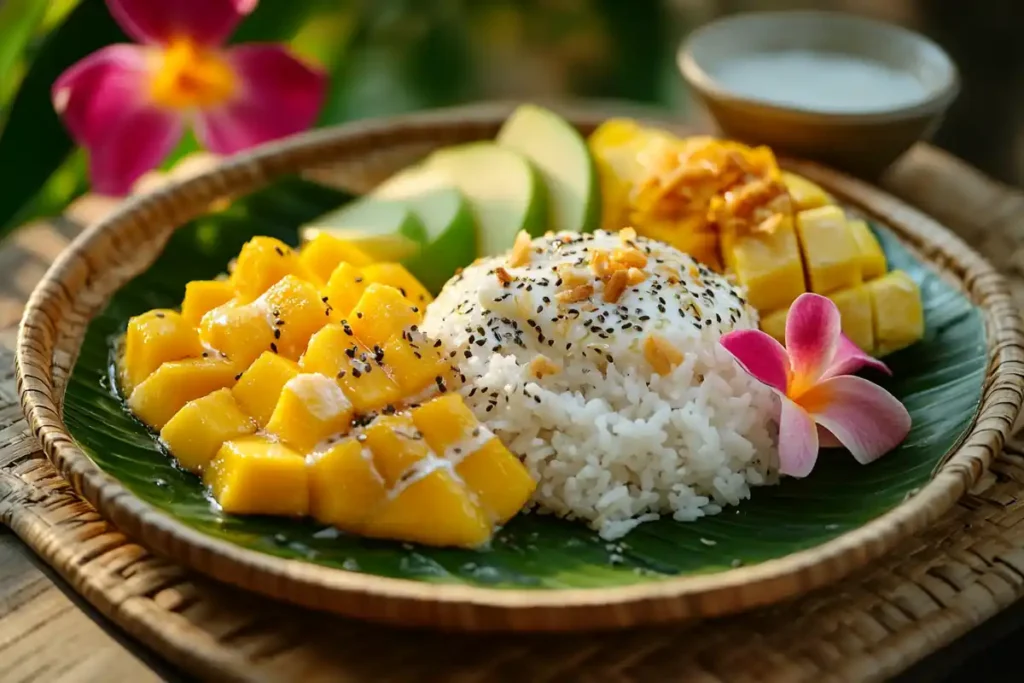
Thai Mango Sticky Rice and Pandan Waffles
In Thailand, mango sticky rice reigns supreme. This dessert features sweet, glutinous rice soaked in coconut milk and paired with juicy mango slices. A drizzle of salted coconut cream elevates the dish, creating a perfect balance of flavors. Its simplicity and reliance on fresh ingredients make it a timeless favorite.
On the other hand, pandan waffles showcase Southeast Asia’s love for pandan—a fragrant leaf that lends a unique aroma and vibrant green hue to dishes. Crispy on the outside and soft on the inside, these waffles are a delightful snack that’s easy to make at home.
Filipino Halo-Halo and Leche Flan
The Philippines is known for its colorful halo-halo, a shaved ice dessert loaded with sweetened fruits, jellies, and beans, all topped with a scoop of ube (purple yam) ice cream. It’s a summertime essential that’s as fun to make as it is to eat.
For something creamier, try leche flan, a rich caramel custard dessert. This Filipino twist on the classic Spanish flan uses condensed milk, making it denser and sweeter. It’s a staple at celebrations and family gatherings.
South Asian Desserts
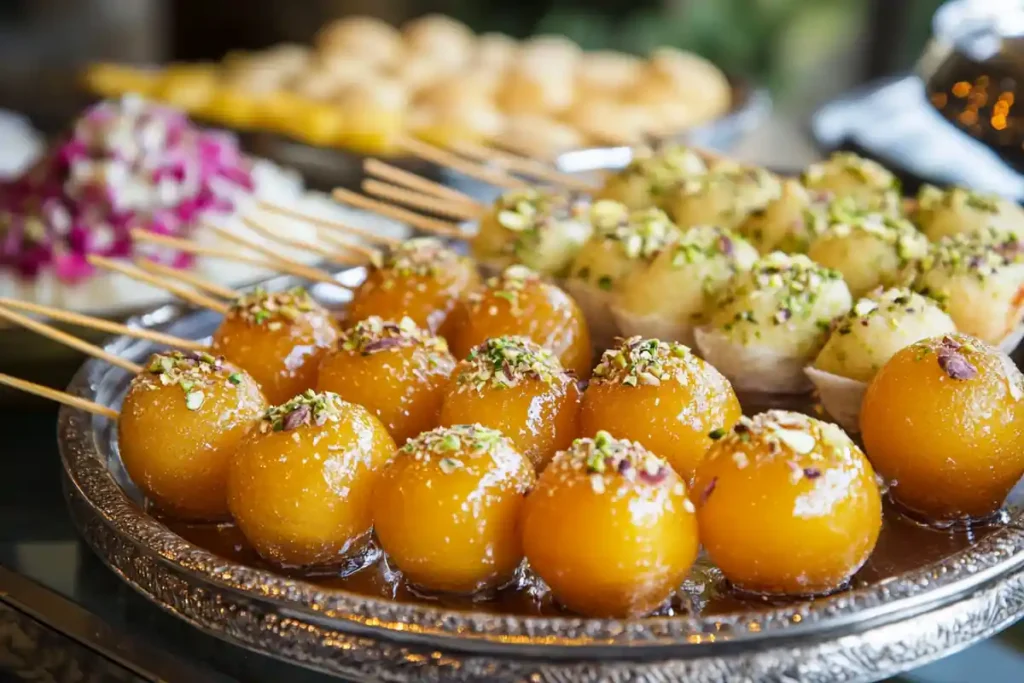
Indian Gulab Jamun and Kulfi
Indian desserts are synonymous with indulgence, and gulab jamun is no exception. These soft, fried milk dumplings are soaked in aromatic sugar syrup flavored with cardamom and rose water. Served warm or cold, they melt in your mouth with every bite.
Another gem is kulfi, a traditional Indian ice cream made with reduced milk and flavored with saffron, pistachios, or mango. Unlike regular ice cream, kulfi has a dense, creamy texture that’s utterly luxurious.
South Asia’s desserts often reflect the region’s love for bold flavors and spices. They’re perfect for anyone with a sweet tooth looking for something out of the ordinary.
Unique Ingredients in Asian Desserts
Key Ingredients in Asian Dessert Recipes
The heart of Asian dessert recipes lies in their unique ingredients. Each element not only adds flavor but also reflects the culinary traditions of its region. Let’s dive into the essential components that make these desserts so extraordinary.
Glutinous Rice and Rice Flour
Rice is a cornerstone of Asian cuisine, and its use extends to desserts. Glutinous rice and rice flour are key in creating the chewy, sticky textures found in treats like mochi, mango sticky rice, and rice cakes. These ingredients act as a versatile base, lending themselves to both sweet and savory variations.
For example, Korean tteok (rice cakes) often feature glutinous rice and are served during celebrations like New Year’s Day. The subtle flavor of rice allows the other ingredients to shine, whether it’s sweet fillings or coconut milk.
Coconut and Coconut Milk
Coconut remains a beloved ingredient in Southeast Asian desserts. Extracted from grated coconut meat, coconut milk adds creamy richness to dishes like leche flan, halo-halo, and Thai coconut jelly. On the other hand, shredded coconut often serves as a topping, enhancing both the flavor and texture of various sweet treats.
Not only does coconut provide a tropical twist, but it’s also widely accessible, making it a staple in traditional Asian sweets. Its subtle sweetness pairs beautifully with ingredients like pandan and palm sugar.
Tropical Fruits (Mango, Lychee, Durian)
Asia is home to an abundance of tropical fruits, many of which are central to its desserts. Mango, for instance, is the star of mango sticky rice and mango pudding. Its natural sweetness and vibrant color make it a crowd-pleaser.
Lychee, with its delicate floral flavor, is often used in syrups, jellies, and sorbets. Meanwhile, durian, known as the “king of fruits,” has a polarizing reputation but is beloved in dishes like durian ice cream and durian sticky rice.
Sweet Beans and Red Bean Paste
Sweetened beans, particularly red beans, are a signature ingredient in East Asian desserts. Red bean paste, made by boiling and sweetening azuki beans, is commonly found in mochi, dorayaki, and Chinese pastries. The paste’s earthy sweetness contrasts beautifully with delicate or rich flavors, making it a versatile filling.
Other beans, like mung beans, are also popular. They’re used in desserts like Vietnamese che or Chinese bean soup, showcasing their ability to transform humble ingredients into elegant treats.
The Secret to Balance
What makes Asian dessert recipes truly unique is the balance of flavors and textures. The combination of sticky, creamy, and crunchy elements, along with the natural sweetness of ingredients like coconut and tropical fruits, creates a harmony that’s hard to resist.
Whether you’re biting into a chewy mochi or enjoying the refreshing chill of halo-halo, the careful selection of ingredients is what makes these desserts unforgettable.
Simple Asian Dessert Recipes You Can Try at Home
Quick and Easy Recipes
Not all Asian dessert recipes require hours of preparation or special equipment. In fact, many are simple enough to whip up with pantry staples. Here are some beginner-friendly recipes to try at home, perfect for those looking to explore the sweet side of Asian cuisine.
Mango Sticky Rice Recipe (15 Minutes)
Mango sticky rice is a Thai classic that’s incredibly easy to prepare. All you need are fresh mangoes, glutinous rice, and coconut milk.
- Cook the glutinous rice until tender.
- Heat coconut milk with a pinch of sugar and salt, then pour it over the rice.
- Serve with sliced ripe mangoes and drizzle with a little extra coconut cream.
The result? A beautifully balanced dessert that’s creamy, sweet, and refreshing.
Matcha Mochi Recipe
If you’re a fan of chewy textures and earthy flavors, this matcha mochi recipe is for you. The green tea powder adds a unique, slightly bitter note that complements the sweetness.
- Combine glutinous rice flour, sugar, and water. Stir until smooth.
- Add matcha powder for color and flavor.
- Steam the mixture until it becomes a sticky dough, then shape into small rounds.
Roll the mochi in cornstarch to prevent sticking, and you’ve got a delightful dessert that’s sure to impress.
No-Bake Coconut Milk Jelly
For those days when you want something cool and creamy, coconut milk jelly is a lifesaver. This no-bake dessert is as easy as it gets.
- Mix coconut milk, water, sugar, and agar-agar powder (a plant-based gelatin alternative).
- Heat the mixture until it boils, then pour it into molds.
- Let it cool and set in the fridge.
The jelly’s silky texture and subtle sweetness make it a hit with kids and adults alike.
Healthy Asian Desserts
Looking for guilt-free indulgence? Asian desserts are a great choice. Many traditional recipes use natural sweeteners like palm sugar or honey instead of refined sugar. You can also tweak recipes by reducing sugar content or opting for whole-grain versions of glutinous rice.
For instance, replace regular leche flan with a coconut milk-based version for a lactose-free alternative. Or, experiment with fresh fruits to add natural sweetness without compromising flavor. Healthy doesn’t have to mean boring when it comes to Asian dessert recipes!
By trying these simple recipes, you can bring the authentic flavors of Asia to your table, no matter where you are. Start small, experiment with flavors, and don’t hesitate to tweak the recipes to suit your taste!
Asian Desserts for Special Occasions
Festive Desserts in Asian Cultures
Asian desserts aren’t just about satisfying your sweet tooth—they play a significant role in festivals and celebrations. Whether it’s a New Year feast, a wedding, or a harvest festival, desserts symbolize prosperity, happiness, and togetherness. Let’s explore some iconic festive Asian dessert recipes and their cultural significance.
Desserts for Chinese New Year
Chinese New Year is a time for family gatherings and feasts, and desserts are an essential part of the celebration. Nian gao (sticky rice cake), for example, is believed to bring good luck and symbolize upward growth. Its sweet and chewy texture comes from glutinous rice flour, and it’s often flavored with brown sugar or coconut.
Another favorite is sesame seed balls (jian dui), deep-fried pastries with a crispy exterior and a soft, sweet filling, usually made with red bean paste. Their round shape signifies completeness and harmony.
Sweets for Indian Festivals
Indian festivals like Diwali and Holi are synonymous with vibrant colors, music, and, of course, decadent desserts. During Diwali, gulab jamun and ladoo are staples, offering rich, indulgent flavors that match the festive spirit. Gulab jamun, soaked in rose-scented syrup, represents the sweetness of life, while ladoo, made from chickpea flour or coconut, symbolizes unity and prosperity.
For Holi, gujiya—a sweet dumpling filled with dried fruits and coconut—is a popular treat, adding a touch of tradition to the colorful celebrations.
Traditional Sweets for Southeast Asian Celebrations
In Southeast Asia, desserts play a key role in cultural festivities. During the Thai New Year (Songkran), mango sticky rice is a must-have treat, offering a balance of sweetness and refreshment perfect for the hot season.
In the Philippines, Christmas celebrations are incomplete without bibingka and puto bumbong. Bibingka is a soft, spongy rice cake topped with butter and salted egg, baked over coals for a smoky flavor. Meanwhile, puto bumbong, a purple rice cake, is steamed in bamboo tubes and served with grated coconut and sugar.
Symbolism in Ingredients
Certain ingredients in Asian desserts hold symbolic meanings, especially during festive seasons. For example, oranges or tangerines are often used as garnishes in Chinese New Year desserts because they represent prosperity and good luck. Similarly, saffron, used in Indian sweets like kulfi and kheer, is associated with luxury and auspiciousness.
Celebratory desserts are not just food—they’re a way to honor traditions, connect with loved ones, and share moments of joy. By recreating these recipes, you can bring a touch of festivity to your home while appreciating the cultural stories behind each sweet treat.
Frequently Asked Questions
What are the 4 main desserts?
Cakes, custards, frozen desserts, and pastries. Examples in Asian cuisine include mochi (cake), leche flan (custard), kulfi (frozen), and egg tarts (pastry).
What is a good dessert after Chinese food?
Light options like mango pudding or almond jelly are ideal after a savory Chinese meal, offering a refreshing and sweet finish.
What is the most popular dessert in Asia?
Favorites include mochi (Japan), mango sticky rice (Thailand), and gulab jamun (India), showcasing regional flavors and traditions.
Who is Catherine Zhang?
Catherine Zhang is a pastry chef known for blending traditional Asian flavors with modern desserts, creating innovative and inspiring recipes.
Print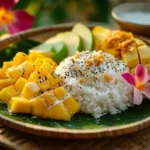
Mango Sticky Rice (Khao Niew Mamuang)
- Total Time: 40 minutes
- Yield: 4 servings 1x
Description
Mango Sticky Rice is a classic Asian dessert from Thailand that combines sweet, fragrant sticky rice, fresh mango slices, and a rich coconut cream drizzle. This simple yet delightful treat is a perfect balance of textures and flavors, offering a taste of the tropics in every bite.
Ingredients
For the Sticky Rice:
- 1 cup glutinous (sticky) rice
- 1 ½ cups water
For the Coconut Sauce:
- 1 cup coconut milk
- ¼ cup granulated sugar
- ¼ tsp salt
For Serving:
- 2 ripe mangoes, peeled and sliced
- 2 tbsp toasted sesame seeds (optional, for garnish)
Instructions
-
Prepare the Sticky Rice:
- Rinse the sticky rice thoroughly under cold water until the water runs clear.
- Soak the rice in water for at least 4 hours or overnight.
- Drain the rice and steam it in a bamboo steamer (or a metal steamer lined with cheesecloth) for 25-30 minutes until tender.
-
Make the Coconut Sauce:
- In a small saucepan, combine the coconut milk, sugar, and salt.
- Cook over medium heat, stirring occasionally, until the sugar dissolves (do not let it boil).
- Reserve ¼ cup of the sauce for drizzling.
-
Combine Rice and Sauce:
- While the rice is still warm, transfer it to a large bowl.
- Gradually pour the remaining coconut sauce over the rice, mixing gently. Let the rice absorb the sauce for about 10 minutes.
-
Assemble the Dessert:
- Divide the sticky rice into portions and place on serving plates.
- Arrange the mango slices alongside the rice.
- Drizzle the reserved coconut sauce over the rice.
- Sprinkle toasted sesame seeds on top for garnish, if desired.
-
Serve:
- Serve the Mango Sticky Rice warm or at room temperature for a truly satisfying dessert.
Notes
- Use ripe, sweet mangoes for the best flavor.
- Glutinous rice is essential for this dish; substitute regular rice only if absolutely necessary, though the texture will differ.
- For added aroma, some recipes include pandan leaves while steaming the rice.
- Prep Time: 10 minutes
- Cook Time: 30 minutes
- Category: Dessert
- Method: Steaming
- Cuisine: Asian (Thai)
Nutrition
- Serving Size: 1 portion
- Calories: 280
- Sugar: 20g
- Sodium: 100mg
- Fat: 8g
- Saturated Fat: 6g
- Unsaturated Fat: 2g
- Trans Fat: 0g
- Carbohydrates: 45g
- Fiber: 2g
- Protein: 4g
- Cholesterol: 0mg
Keywords: Mango Sticky Rice, Thai Dessert, Coconut Sticky Rice

